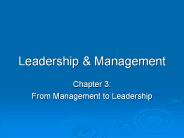Leadership - PowerPoint PPT Presentation
1 / 17
Title:
Leadership
Description:
B) Do I have sufficient information to make a high-quality decision? ... the leadership style ... have high need for power, but low need for affiliation, and ... – PowerPoint PPT presentation
Number of Views:42
Avg rating:3.0/5.0
Title: Leadership
1
Leadership
2
Questions to Ponder
- What is leadership?
- A personal attribute of the leader?
- Leading behaviors?
- Characteristics of groups?
- What makes a good leader?
- Personality traits?
- Favorable situation?
- Interaction between situation and traits?
- Where does a leaders power come from?
3
What Makes a Good Leader vs. Who Becomes a Leader?
- Leader effectiveness
- The study of what makes a leader good or
effective - Leader emergence
- The study of who will emerge as a leader and why
- The two are not always the same thing
- can get a leader who is completely ineffective
- good workers dont always make good bosses
4
Where does a leaders power come from?
- Expert Power
- leader has knowledge others need
- others know s/he has the knowledge
- Legitimate Power
- power by virtue of the hierarchical nature of
supervisor-subordinate
- Reward Power
- power to control rewards such as salary, bonuses,
promotions, praise - Coercive Power
- power to punish AND willingness to use power
- Referent Power
- power because others like you and want you to
like them
5
Theories of Leadership
- Trait Theories
- Needs for power, achievement, and affiliation
- Task vs. Person orientation
- Situational Approach
- Vroom-Yetton model of decision making ((described
in Ch. 14) - Situation/Trait Interaction Theories
- Fiedlers contingency approach
6
McClellands Need Theory
- High performance leaders will demonstrate
- high Need for Power
- low Need for Affiliation
- Presidential Examples
- High Power and Low Affiliation
- Reagan, FDR
- Low Power and High Affiliation
- Harding, Nixon
- What about need for achievement?
- Theory doesnt say (Carter Nixon)
7
Task vs. Person Orientation
- Difference in leader performance can be
explained by extent to which leader is task vs.
person oriented - Task-oriented leaders
- manage/lead by instruction, goal setting
- task-focused
- Person-oriented leaders
- show concern for subordinates
- are warm and supportive
- are more hands-off
8
Predictions of Task vs. Person Orientations
9
Situational Approach (Vroom-Yettons Model of
Decision Making)
- Seven questions a leader must answer
- A) Is the quality of the decision important?
- B) Do I have sufficient information to make a
high-quality decision? - C) Is the problem structured?
- D) Is acceptance of the decision by subordinates
important for effective implementation? - E) If I were to make the decision by myself, is
it reasonably certain that is would be accepted
by my subordinates? - F) Are subordinates motivated to attain
organizational goals? - G) Are subordinates likely to disagree with
proposed solutions?
10
The Decision Making Tree
11
Decision Making Types
- Autocratic Decision Making
- AI You make decision yourself with current
information - AII You obtain needed info from subordinates,
then make decision yourself - Consulting Decision Making
- CI You share problem with subordinates
individually and gather their input. You make
decision that may or may not reflect their input. - CII Same as CI but gather input from
subordinates in a group - Group Decision Making
- GII Share problem with subordinates as a group.
Collectively, you generate and evaluate
alternatives. You choose a solution that has
group consensus.
12
Fiedlers Contingency Model
- A leaders effectiveness is contingent on
- the characteristics of the situation
- the leadership style
- Leadership will be effective only if there is a
good match between the specific leadership style
and the favorability particular situation
13
Defining Leadership Style
- How do you rate the person you least like to work
with? - If nasty, unfriendly, unpleasant, gloomy
- Low LPC (task-oriented)
- If friendly, pleasant, cheerful
- High LPC (person-oriented)
14
Situation Favorability
- Situation is more favorable if
- task is structured
- leader has clear legitimate power
- subordinates like the leader
- most important variable
15
Predicting Leader Success
16
Which type of leader will be most effective??
- Well-liked experienced supervisor in charge of a
production line - Well-liked departmental chair with many tenured
faculty charged with the mission of improving
teaching, research, and service - Not-well liked president of volunteer student
club trying to organize club activities for the
year
17
Putting It All Together
- The best leaders are
- intelligent,
- high self-monitors,
- high in task and person orientations,
- have high need for power, but low need for
affiliation, - and are emotionally stable
- The more skills the leader has, the more the
leader will be able to adapt to the situation - The more the leader is able to recognize the true
situation and his/her own leadership style, the
more likely it is s/he will make the correct
decision































